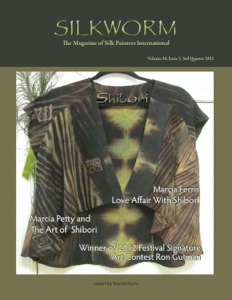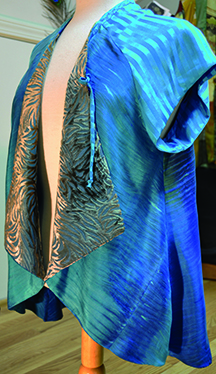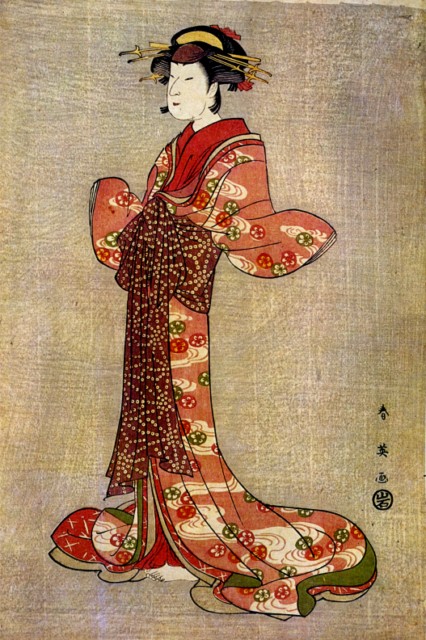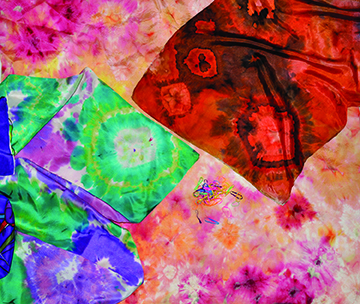Silkworm Magazine, Volume 18, Issue No. 3, September 2011
|
This is an issue devoted to the fine art of the Japanese art form called shibori. Marcia Ferris creates shibori while Marcia Petty gives a little history on the ancient art. Addie Chernus demonstrates her own personal shibori techniques. Ron Gutman, winner of the signature contest. |
 |
In This Issue |
Marcia Ferris - A Love Affair With Shibori
by Deborah Younglao
 |
| Blue Shibori Jacket by Marcia Ferris |
I first met Marcia on Facebook, in the spring of 2010. Besides a love of silk painting, we discovered that we lived only an hour apart and that our birthdays were only days apart. We started corresponding on Facebook and finally met in person at Silk in Santa Fe that year. We are both now part of the only SPIN chapter in North Carolina, which meets in Marcia’s studio and of which Marcia is Program Director (she doesn’t like the title “President” but she is the de facto president!). Marcia’s studio is a wonderland of painted silks and silk painting materials, toys and gadgets. Racks of painted scarves and jackets line the walls.
Marcia says that she doesn’t consider herself an artist. I beg to differ and am sure that after seeing her work, you will too.
Where are you from originally and how did you wind up in North Carolina?
Originally I am a beef cattle and tobacco farm gal from central Kentucky. Still have the farm there along with my sister and brother. I graduated from University of Kentucky with a degree in Education. My husband, Martin, and I moved many times over the years with our son and daughter. Martin was employed in the chemical industry. I taught elementary school in Kentucky, Louisiana, Texas and Florida before moving to Pennsylvania and now North Carolina. We are now in North Carolina because our two children and granddaughters are close. My husband has retired. To read more about Marcia, see Volume 18, Issue 3.
The Art (and History) of Shibori
by Marcia Petty
 |
|
Image of Kimono |
I can’t remember when shibori first sparked my interest. It was probably in the 80’s. Living in San Francisco and shopping for ikat at Kasuri Dyeworks in Berkeley probably was the source. Also, Sandra Sakata’s shop Obiko on Sutter Street near Union Square was a constant source of inspiration. I didn’t shop there – too expensive (but I sure wanted to). The great local wearable art was there, and I say “art” with a hefty respect for the garments and accessories that flowed through those doors. It was a great loss when Sandra (born in 1940) died of breast cancer in 1997. A mover and shaker in the “Art to Wear” movement at Obiko, Sandra Sakata showcased textile artists whose works were unique artistic statements.
By the mid to late 80’s I was the proud owner of Yoshiko Wada, Mary Kellog Rice, and Jane Barton’s ground-breaking book, “Shibori, The Inventive Art of Japanese Shaped Resist Dyeing: Tradition, Techniques, Innovation.” This, for me, is a bible cum primer of shibori techniques. I still don’t find it all easy to understand; nevertheless, consider it a “must have” reference for those wishing to acquire this art. It addresses the technical aspects of shibori in the classical Japanese tradition at a very high level. To be familiar with its content would be a great accomplishment, providing a platform for infinite artistic departure and improvisation. Today there are many diverse interesting texts delineating old and contemporary interpretations of shibori. There are also YouTube videos, some of which are very useful.
To read more about Karen, see the article, “Flowers from the Heart” in Silkworm V 18, I 1).
|
|
Learn Shibori Techniques with
|
 Samples of Shibori Projects
Samples of Shibori Projects